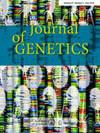神经孢子虫fmf-1:诱惑与爱情。
摘要
粗神经孢子虫fmf-1突变体具有独特的表型。无论突变体是否作为雄性或雌性亲本与野生型(fmf-1 x fmf-1+)杂交,当子实体(周皮)仅达到正常直径的40%时,它就会阻止性发育。我第一次了解fmf-1是在该杂志邀请我评论由d.d. Perkins, A. Radford和m.s. Sachs撰写的《神经孢子菌简编:染色体位点》时(J. Genet, 80: 53- 54,2001)。该纲要还告诉我,这里发表了第一个神经孢子虫遗传图谱(J. Genet. 32,243 - 256,1936)。该突变体是由t.e. Johnson发现并鉴定的,他也将突变定位在1号染色体的一个超过3.3 Mb的DNA片段上(遗传学92,1107 - 1120,1979)。30年后,我的实验室发表了第二篇fmf-1论文。我们将突变定位到一个单一的碱基对,即一个T: a到a:T翻转突变,从而确定了改变的基因(J.遗传,88:33-39,2009)。为了绘制fmf-1,我们利用了我们的专业知识,使菌株具有染色体片段复制。Dp菌株是在野生型与易位菌株(WT x T)杂交中产生的。易位将一条染色体的一部分转移到另一条染色体上。用Dps将fmf-1定位到330 kbp的段。传统的交叉映射和非交叉选择随后将其定位到33 kbp段。这个间隔足够小,可以通过测序DNA来发现突变。Fmf-1蛋白激活交配信息素信号所需的基因。fmf-1雄性配子(分生孢子)不能分泌吸引fmf-1+雌性性结构上受体的信息素(原石质)。相反,fmf-1蛋白不表达来自fmf-1+分生孢子的信息素的同源受体。因此,fmf-1+ x fmf-1杂交不能使原鞘细胞受精,阻碍了它们向鞘周成熟。基因作图,尤其是Dp作图,现在已经不能打动许多非遗传学家了。WT × T杂交如何产生Dp后代?为什么需要Dps和交叉?为什么选择反对非交叉?为什么不直接对野生型和突变型的基因组进行测序,找出突变型中DNA发生改变的基因,然后逐一进行测试呢?许多人忘记了DNA测序,特别是“难以获取”的着丝粒序列,当时并不那么容易和便宜。分离fmf-1为我们提供了富集rip缺陷突变体的可能性。RIP是一种突变过程,发生在有性杂交期间,在单倍体神经孢子虫基因组中复制的任何DNA序列的所有拷贝中诱导多个G:C到a:T的转变突变。这是生物学中已知的最具诱变性的过程。据称,连锁重复基因的突变频率为95%或更多(J. Genet. 75: 313-324, 1996)。我的学生,Srividhya Iyer,通过在内源性基因5kbp内插入第二个fmf-1拷贝,创建了一个链接的fmf-1复制。大多数来自重复纯合杂交的后代将继承rip突变的fmf-1等位基因,使他们不育。如果将f1后代大量萌发,并允许随机杂交,则只有少数非riped后代之间的杂交才能产生f2。同样,对于f3, f4,等等。因此,后代的rip缺陷突变体逐渐丰富。在Iyer检测的f1后代中,rip诱导的fmf-1突变率不是95%,而“仅仅”是85%,富集效率低于我们的预期。因此,浓缩尝试被放弃。这不是第一次,也不是最后一次,一个美丽的战略被一个丑陋的事实扼杀了。The Neurospora crassa fmf-1 mutant has a unique phenotype. It arrests sexual development when the fruiting bodies (perithecia) attain only 40% of their normal diameter, regardless of whether the mutant participates in a cross with the wild type (fmf-1 x fmf-1+) as the male or female parent. I first learnt about fmf-1 when this journal invited me to review 'The Neurospora compendium: chromosomal loci' by D. D. Perkins, A. Radford and M. S. Sachs (J. Genet. 80: 53-54, 2001). The compendium also informed me that the first Neurospora genetic map was published here (J. Genet. 32, 243-256, 1936). The mutant was discovered and characterized by T. E. Johnson, who also localized the mutation to a chromosome 1 segment that spanned more than 3.3 Mb DNA (Genetics 92, 1107-1120, 1979). The second fmf-1 paper came 30 years later from my laboratory. We mapped the mutation to a single base pair, a T:A to A:T transversion mutation, and thus identified the altered gene (J. Genet. 88: 33-39, 2009). To map fmf-1, we leveraged our expertise in making strains bearing chromosome segment duplications. The Dp strains were generated in crosses of the wild type with translocation strains (WT x T). A translocation transfers a segment of one chromosome into another. Mapping with Dps localized fmf-1 to a 330 kbp segment. Conventional mapping with crossovers and selection against noncrossovers subsequently localized it to a 33 kbp segment. This interval was small enough to pick up the mutation by sequencing its DNA. The Fmf-1 protein activates genes required for mating pheromone signalling. The fmf-1 male gametes (conidia) fail to secrete the pheromone that attracts receptors on the fmf-1+ female sexual structures (protoperithecia). Conversely, fmf-1 protoperithecia do not express the cognate receptor for the pheromone from the fmf-1+ conidia. Consequently, the fmf-1+ x fmf-1 cross fails to fertilize protoperithecia and arrests their maturation into perithecia. Genetic mapping, especially Dp mapping, fails to impress many nongeneticists these days. How do WT x T crosses produce Dp progeny? Why are Dps and crossovers even needed? Why select against noncrossovers? Why not just sequence the genomes of the wild type and mutant, identify genes whose DNA is altered in the mutant, and then test them one by one? Many forget that DNA sequencing, especially of 'hard to access' centromeric sequences, was not as easy and inexpensive then. Isolating fmf-1 offered us the possibility of enriching for RIP-defective mutants. RIP is a mutational process that occurs during a sexual cross and induces multiple G:C to A:T transition mutations in all copies of any DNA sequences duplicated in the otherwise haploid Neurospora genome. It is the most mutagenic process known in biology. Reputedly, linked duplications were 'mutated at frequencies of 95% or more' (J. Genet. 75: 313-324, 1996). My student, Srividhya Iyer, created a linked duplication of fmf-1 by inserting a second copy of it within 5 kbp of the endogenous gene. Most progeny from duplication-homozygous crosses would inherit a RIP-mutated fmf-1 allele, rendering them infertile. If the f1 progeny are germinated en masse, and allowed to randomly inter-cross, then only crosses between the minor fraction of non-RIPed progeny can generate the f2. Likewise, for the f3, f4, etc. Later generations, hence, become progressively enriched for RIP-defective mutants. In the f1 progeny examined by Iyer, the RIP-induced fmf-1 mutant fraction was not 95%, but 'merely' 85%, a lesser enrichment efficiency than we desired. Therefore, the enrichment attempt was abandoned. This is not for the first time, nor the last, that a beautiful strategy was killed by an ugly fact.

 求助内容:
求助内容: 应助结果提醒方式:
应助结果提醒方式:


